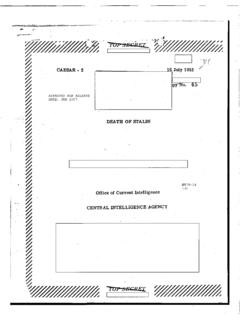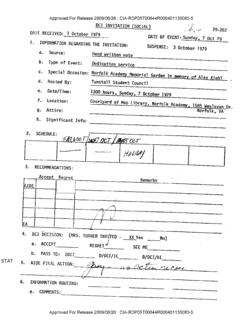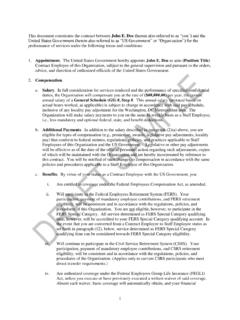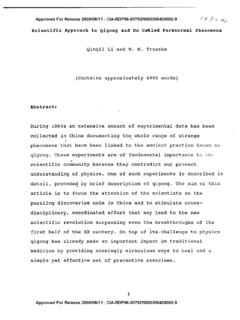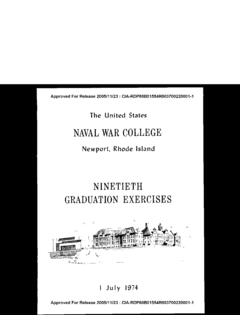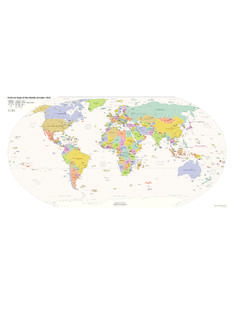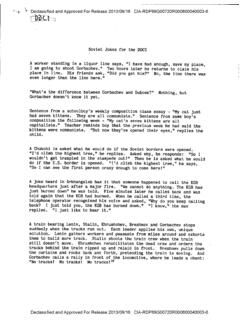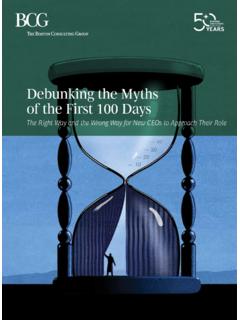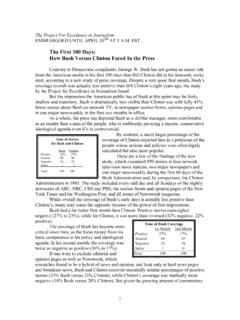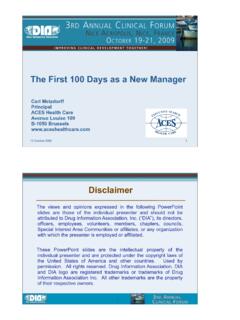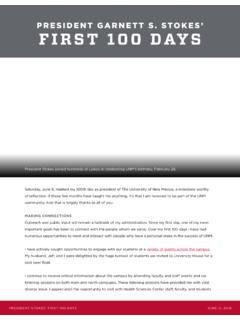Transcription of Fifteen DCIs' First 100 Days - Welcome to the CIA Web Site
1 Taking stockFifteen DCIs' First 100 DaysCIA History StaffEditor's Note: These brief sketches convey some sense of the pace and preoccupations of 15 Directors ofCentral Intelligence (DCIs) in their First 100 days . No regular cycles or predictive patterns emerge; some DCIseased into their jobs, while others found themselves suddenly reacting to wars, scandals, or , DCIs Smith, McCone, Schlesinger, Colby, and Gates managed major changes in CIA's structureand mission in the 100-day span. The History Staff in CIA's Center for the Study of Intelligence originally prepared this work in January 1993 asa background paper for the new DCI, R.
2 James Woolsey. Seven of the staff's historians, Nicholas Cullather,Gerald Haines, Scott Koch, Mary McAuliffe, Kevin Ruffner, Donald Steury, and Michael Warner, drafted theindividual sketches, and the staff's chief, J. Kenneth McDonald, edited them into final form. A few changeshave been made in the original version for editorial and declassification reasons. Although this is an officialCIA History Staff product, the views expressed--as in all of its works--are those of the authors and editor and donot necessarily represent those of the CIA.
3 RAdm. Sidney Souers, US Naval Reserve The shape of the postwar world was still uncertain when Sidney Souers on 23 January 1946 became the firstDCI for the newly created Central Intelligence Group (CIG). A wealthy St. Louis businessman and NavalReservist who had impressed Navy Secretary James Forrestal, Souers had risen to Deputy Chief of NavalIntelligence during the war. Now 53, he agreed to take on one more task before returning to civilian life and hisbusiness interests in Missouri. At the White House on 24 January, President Truman read a mock proclamationand presented Souers with a black cloak and wooden dagger as the vestments and appurtenances of his newposition as "director of centralized snooping.
4 " Souers had helped draft the directive for the new CIG, which was not intended to challenge the position of thedepartmental intelligence services. Directed to coordinate, plan, evaluate, and disseminate intelligence, and toprovide services of common concern, CIG had no clear authority to engage in clandestine collection or covertoperations. Souers ensured that CIG would survive his brief tenure and begin to fulfill its mission of coordinating the USintelligence activities. He gathered a cadre of experienced and mostly military intelligence professionals withsome difficulty, because CIG was only grudgingly staffed and funded by the Departments of State, War, andNavy.
5 By April he had also maneuvered successfully to gain responsibility for the resources of the WarDepartment's Strategic Services Unit, the remnants of the substantial foreign intelligence capability the Officeof Strategic Services had built up during the war. At Truman's request, CIG also collated the deluge of Army, Navy, and State Department cables, dispatches, andreports that arrived daily, and produced a comprehensive intelligence summary for the White House; the firstDaily Summary was delivered less than four weeks after Souers became Director.
6 He never managed to getmuch cooperation from State, and the military services refused even to provide CIG with information on theirown capabilities and intentions. When Souers left office on 10 June 1946, CIG's professional and clericalpersonnel numbered about 100. 1 of 115/30/2006 7:39 AMStudies in Intelligencefile:///A|/Studies in Gen. Hoyt Vandenberg, US Army The CIG's inherent weaknesses had become glaring by the time DCI Souers began thinking about who shouldreplace him. In Hoyt Vandenberg, the 47-year-old nephew of powerful Republican Senator Arthur Vandenbergand General Eisenhower's intelligence chief since January, Souers saw just the man to give CIG the leadershipand connections it needed.
7 President Truman's aides persuaded Eisenhower to part with his new G-2, andVandenberg became the second DCI on 10 June 1946. Vandenberg had learned the value of coordinated collection and analysis as commander of the 9th Air Force inthe European war. An ambitious officer who hoped to head an independent Air Force, he set aside his parochialservice concerns and worked hard to give CIG greater freedom from State and the military. His First months onthe job saw enormous changes in CIG. Vandenberg campaigned to double its budget and vastly expand its the objections of the State Department and J.
8 Edgar Hoover's FBI, he won for CIG monopolies onclandestine collection and foreign counterintelligence, as well as the right to conduct independent research andanalysis. For these new roles Vandenberg in July established the Office of Special Operations and the Office of Reportsand Estimates, and in the same month took over intelligence operations in Latin America from the FBI. Tomanage this growing structure, he reorganized and strengthened the Office of the Director, subjecting it tomilitary staff discipline under the supervision of the colonels he had brought along from Army G-2.
9 When President Truman asked CIG to assess the Soviet Union's increasingly worrisome behavior, Vandenbergoversaw the crash production of ORE-1, the predecessor of the CIA's National Intelligence Estimates. This firstEstimate of 23 July 1946 predicted that Soviet foreign policy would continue to be "grasping andopportunistic," but also judged that Stalin still had neither the capabilities nor the desire for all-out war with theWest. By early September, when he won the right for CIG to have its own budget and to hire and fire its ownpersonnel, Vandenberg had in principle recreated an intelligence organization with all the powers--except forcovert action--of the wartime OSS.
10 By then Vandenberg had also begun his campaign to place the CIG on afirmer legal footing, an aspiration fulfilled early in his successor's term. RAdm. Roscoe Hillenkoetter, US Navy Roscoe Hillenkoetter had gained an appreciation for intelligence and clandestine operations as naval attach inVichy France in 1940-41. A 1919 Naval Academy graduate, Hillenkoetter had been wounded at Pearl Harborand had served as Admiral Nimitz's intelligence officer in the Pacific in 1942-43. Always a sailor at heart, hehad commanded the USS Missouri in late 1945, and he returned to command cruisers off Korea when he leftCIA in 1950.
